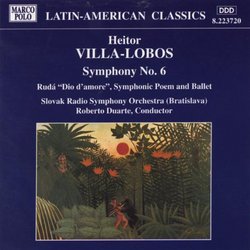More splendid and unknown Villa-Lobos by Duarte and Marco Po
Discophage | France | 11/17/2008
(5 out of 5 stars)
"I would venture to say that Villa-Lobos is an unknown composer. The claim may sound preposterous in the face of the popularity of the Bachianas Brasileiras and some of the Chorôs. But Villa-Lobos was an incredibly prolific composer, and most of his output other than the famous warhorses is hardly known, played and recorded. Yet much of it is superb. The sonic, melodic and orchestral imagination just poured out of the composer's pen, nourished by the sap of the Amazonian forest and Brazilian popular culture. In the mid-1990s conductor Roberto Duarte and Marco Polo released four CDs devoted to lesser-known aspects of the composer's orchestral music, and this is one of them (for the others see my reviews of Genesis / Erosao / Amazonas, Villa-Lobos: Symphonic Dances (Rudepoema; Dancas caracteristicas africanas; Danca frenetica; Danca dos mosquitos) and Villa-Lobos: Discovery of Brazil Suites Nos. 1-4).
The 6th Symphony was composed in 1944 and is subtitled "On the Outline of the Mountains of Brazil". Villa Lobos invented a process to devise melodic lines after the outline of a mountain or landscape first shown on a photograph, than transferred on squared paper by means of a pantograph (a mechanical device designed to reproduce drawings on a different scale). I can't say I really understood the explanations given in the liner notes as to how that drawing then produced note values and durations, but anyway those "kitchen" considerations don't matter a bit. If those processes were used to create music of no value, one would laugh. Here, the music is superb and one can forget about the process. The construction seems relatively free, each movement is compact is says no more than what needs to be said, and the composition displays again Villa Lobos' lush and magnificent orchestral imagination. The music reaches epic proportions and the second movement is beautifully atmospheric, with eerie string glissandos and noises of the forest on the woodwinds, also rising to epic grandeur. I don't have the subsequent and competing recording of Carl St. Clair on Cpo to compare Duarte's reading (Villa-Lobos: Symphonies Nos. 6 & 8). In my past experience of Duarte's Villa Lobos offerings, he is powerful but sometimes trudging. But as it is I am happy to just enjoy the music, all considerations of interpretation aside, all the more so as there is no competition for the second composition offered here, the "symphonic poem and ballet" "Rudà, God of Love".
Composed in 1951 for a planned performance at La Scala in Milano which eventually didn't happen and first performed in 1954 with the composer conducting the Orchestre National de France, it is even better than the Symphony. Villa Lobos' "Amazonian" inspiration produced a host of wonderful compositions - see Duarte's other Marco Polo installments, or Stokowski's Uirapuru (Villa-Lobos/Prokofiev/Debussy) for more examples. Rudà is the god of love and creation in the mythology of the Marajoaras ("a pre-Columbian society that flourished on Marajó island at the mounth of the Amazon river" between 800 and 1400 AD, says the invaluable free user-processed Internet encyclopedia). It is exuberant, boisterous, sometimes even raucous, again exuding an epic sweep, alternating with beautifully atmospheric and evocative passages. Again the music is highly imaginative in its instrumental invention - try cello and what I think is a harmonium at 5:10 in the first movement (track 5), and I'm not quite sure what reed instrument is playing at 2:53 in the second movement (track 6), oboe or cor anglais, but I've never heard it sound that way, with so much perky sauciness.
"


 Track Listings (10) - Disc #1
Track Listings (10) - Disc #1